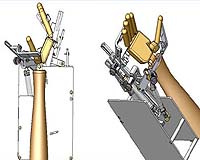Robotic Therapy for Hand

A hand-wrist assisting robotic device (HWARD) designed by researchers from University of California helps stroke patients by improving their ability to grasp and release objects. Studies have shown that repetitive training on movements helps in the rehabilitation of the affected arm and hand. Hence, HWARD was developed to provide aid to the patient by having a pattern of ‘wrist extension with hand grasping’ and ‘wrist flexion with hand release’ when handling objects. The design follows the neurobiological principles of motor learning – sensorimotor integration, environmental complexity, attention and movement repetition [1].

As shown from the figures, HWARD enables rotation of the thumb, fingers and wrist. Also, a lever design is used to enable joint movement. This makes use of air cylinders attached to the level and the air pressure can be adjusted to aid movements.
HWARD is activated by 3 air cylinders and the air pressure is regulated so that the air cylinders produce approximately 4 to 25N of force. This is done with precision regulators which control the source air pressure levels entering the system. In addition, sensors are attached to the joints and cylinders to provide significant data for computation. For instance, rotary potentiometers measure the finger, wrist and thumb joint angles, micro pressure sensors on air cylinders measures pressure levels.
A computer program then allows the experimenter to control specific functions, perform safety shutdowns and collect information about the joint angles and pressure.
The patient has to initiate the motor command. In cases where the hand can only move minimally, the robot can be controlled to complete the task so that the brain will re-learn what it is like to make the full grasp or release. With HWARD, stoke patients can regain their normal hand function to cope with daily chores.
[2] http://www.redorbit.com/news/technology/833236/robotic_therapy_restores_hand_use/index.html
[3] http://www.spacedaily.com/reports/Robotic_Arm_Aids_Stroke_Victims_999.html